Since George R. Hermann gifted Hermann Park to Houston in 1914, it has become a bonanza of amenities. The zoo, the lake, and the miniature train ride are great for kids; the outdoor theater, Japanese garden, and a golf course for grown-ups. Playgrounds and picnic pavilions dot the park’s grassy areas like mushrooms.
2014 is the park’s centennial, and there has been a massive renovation, sponsored by its well-connected advocacy and fundraising organization, the Hermann Park Conservancy. Among the new features is Art in the Park, an expensive, image-polishing temporary art exhibition. Eight pieces are conveniently arranged along the kiddy-train tracks that loop through the park, and in the 96-degree sun, the $3.25 train ride is the best bet for a quick tour.
On the way to the ticket booth, you may pass Reframe X-Frame, a silvery metal pod like a short shipping container next to the paddleboat rental. You might mistake it for a public restroom, but it’s the brainchild of four University of Houston departments. The piece included text panels explaining why it isn’t really as uninteresting as it looks, but even my art-critic Code of Honor couldn’t make me read them. Inside, it’s like a hallway of school lockers, filled with the clicks, hoots and buzzes and hisses of Abinadi Meza‘s Vein of Sky, an automatically-generated sound piece based somehow on the trees and wind. Despite its expectable, pseudo-scientific methodology, Vein of Sky is the best thing about the pod.
Once I was aboard the tiny train, things got better. The first piece we passed was Portable Trojan Bear by Jim Love, located near this spot since 1984, and not part of the current show. It’s semi-fun. Low on interactivity and bright colors, but high on quirkiness, the piece is an interesting midpoint in the transition of public artworks from heavy, un-fun monuments to the attention-grabbing spectacles of today.
“Look at the red! Modern art!” a woman ahead of me urged her toddler, pointing at Yvonne Domenge’s Wind Waves, an eye-grabbing bauble across from the Museum of Natural Science, and saying all there is to say about the piece.
The main attraction, a Louise Bourgeois Spider, had already been removed, but it was easy to imagine it dragging a struggling, web-wrapped Sam Houston into the reflecting pool. Those shriveled bugs are the Starbucks of public art.
Patrick Dougherty’s Boogie Woogie is a maze inside a Hobbit-hut. Twined from cut branches and surprisingly sturdy, it gave me a new appreciation for wattle as a building method. Threading its winding passages, you feel like a rabbit or woodchuck in a Beatrix Potter picture book, until you suddenly imagine yourself in a scene from the Blair Witch Project. A must-see for anyone who has ever built a fort in the woods.
On this hot, hot day, Sharon Engelstein‘s Dillidiidae, a set of concrete bubbles on an un-shaded hill, was the loneliest play structure in the park. Translated directly from her inflatable sculptures into textured concrete, they lose the wobbling enormity that makes the inflatable pieces impressive. Together, the six objects form an unmistakable family unit. The big pink one’s the mama, surrounded by a litter of tubby, limbless infants. Despite the gay colors, it’s a wry and resigned view of parenthood as breeding, especially located a stone’s throw from the park’s main playground.
According to the conservancy’s website, there is no safe pedestrian access to the tunnel housing Trenton Doyle Hancock’s Destination Mound Town. It is only visible from the train, but is far too busy to appreciate in the few seconds it takes the train to pass through. This is actually good; the piece is permanent, and thirty years of tiny train rides won’t wear out its surprises. I can imagine my grandchildren pointing things out to me that I hadn’t noticed.
If you just can’t wait thirty years, there’s no “keep out” sign on the tunnel (yet), and the Art Critic’s Code turns a blind eye on harmless trespass in the service of knowledge. Wide Astroturf walkways on both sides of the tracks make for perfectly safe, leisurely viewing.
Destination Mound Town is a mural crawling with fine art and cartoon references, odd characters, and funny ambiguous situations. Hancock has masterfully captured the creepy hyper-happiness of carnivals and arcades, hinting at the dark scatological humor so abundant in his other works while keeping it family-friendly. I was disappointed that it wasn’t an original painting — the piece is digitally printed onto wallpaper — but then, I wasn’t supposed to get close enough, or stay long enough, for it to matter.
The Rice University Building Workshop‘s Convergence isn’t quite a building, nor is it good art. About the size and shape of a bus shelter, it’s an aimless geometric toy standing near, but not on, the Metro light rail line. Parallel plastic-coated cables in steel frames form harp-like planes, but are too loose to pluck, and too thin to offer any shade. I suppose you could sit on the concrete blocks anchoring the thing, but why would you want to?
I don’t think it’s fair to critique art for not living up to its artist statement, but the blurb about this piece on the Conservancy’s website reads like a geometry problem written in Architect-speak, and illustrates the wrong-headed thinking that leads to these kinds of insensitive abominations.
“Situated within four existing trees, the pavilion is composed of a quadrilateral ground plane containing integrated benches and, rotated above the base, a triangular frame. The cast concrete benches for seating are engineered to act as foundation elements (taking the place of costly and invasive footings). The triangulated steel structure is designed to provide a rigid framework and to visually extend into the lower tree canopy. The infill of woven cord gives a sense of enclosure and operates as an ephemeral scrim to the larger site beyond.”
In a bygone age, the piece’s arbitrary geometry might have symbolized the hope that technology would build a better world, but today it’s just a depressing reminder of how much of our built environment is composed of similarly unloved and unresponsive structures. I’ll take Patrick Dougherty’s Boogie Woogie over this anytime.
Bill Davenport is the Texas Editor-in-Chief of Glasstire.



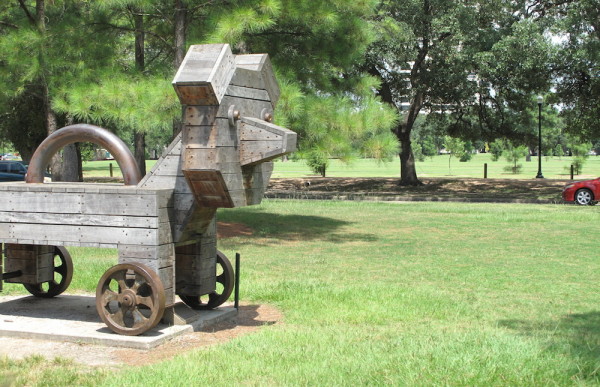
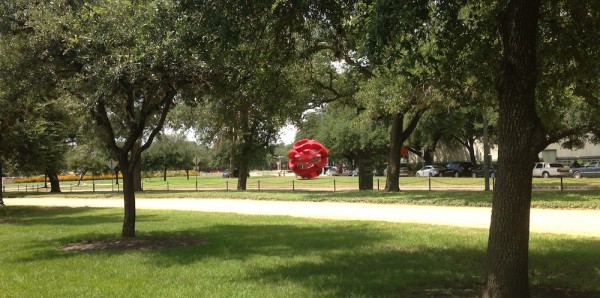
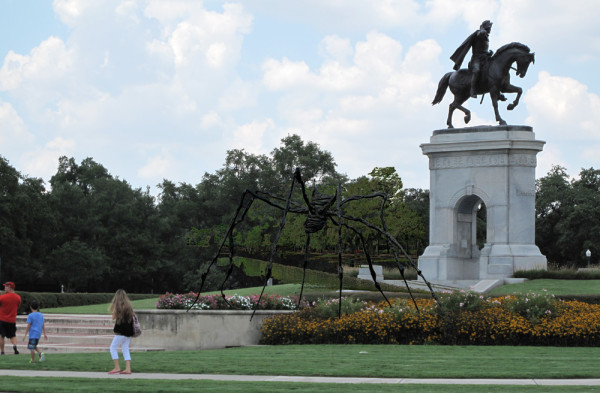
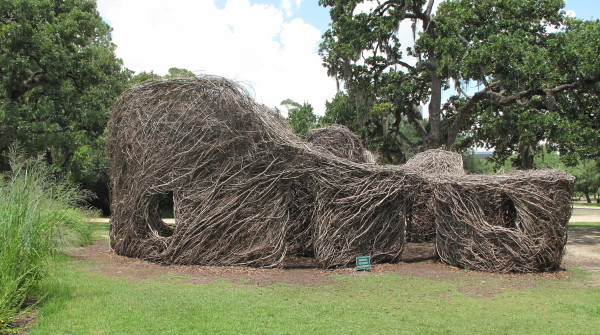
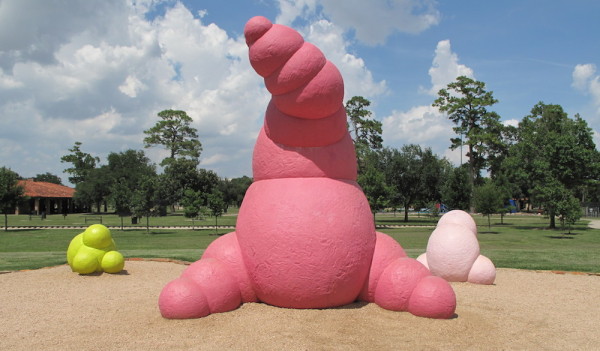
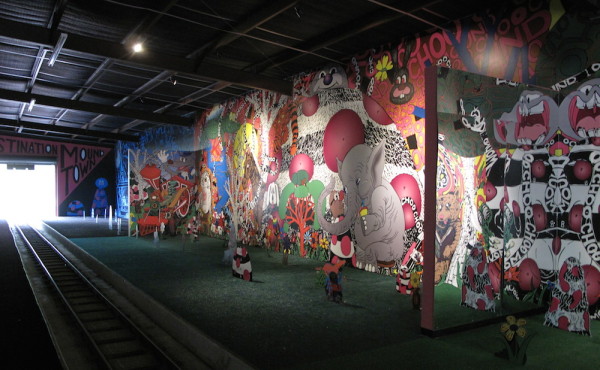
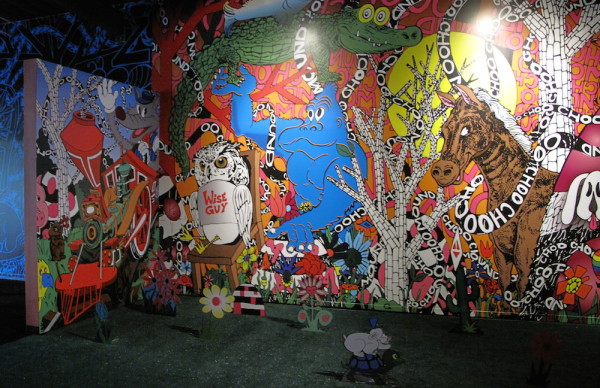
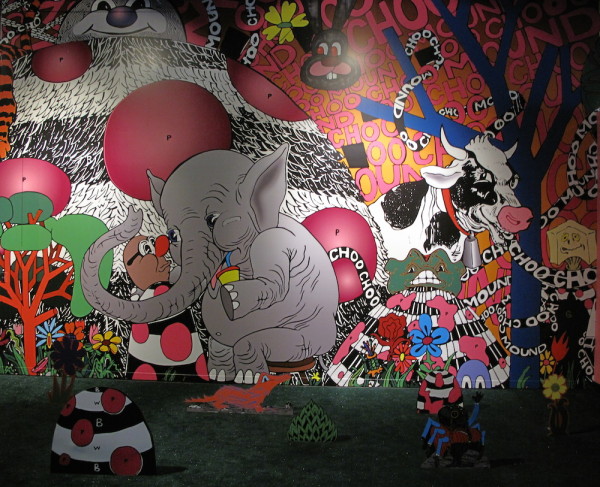
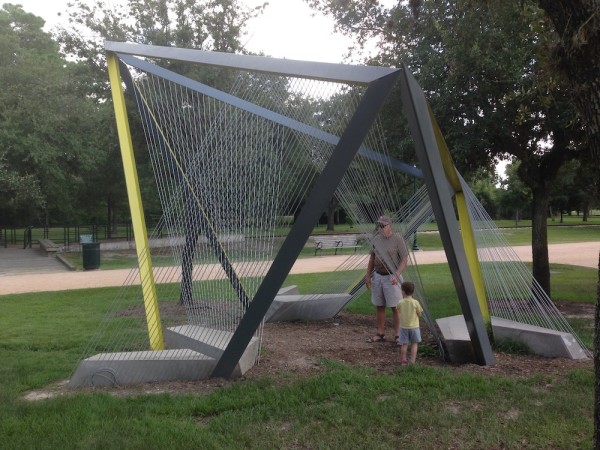

3 comments
Jim Love’s sculpture is indeed a Trojan Bear. Crawl underneath. Quirky boy bear.
It’s a shame no one’s done anything on the tracks themselves yet. Something guerrilla and kinetic (very fast). Even Wind Waves would be terrific with four wheels!
BILL:
Convergence is my favorite and the description is very meaningfully descriptive of what is there. Of itself so. Why does it need to be quirky?